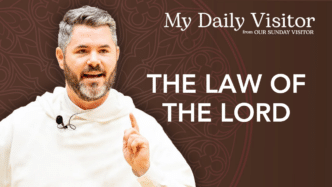It was thirty-six degrees in the shade and forty-two degrees in the blazing sun. On Thursday, August 6, 2020, in suffocating heat, the monks set out for their weekly walk.
Guests and families sought refuge beneath the lime trees, children slept under the trees in the grand alley, but the Benedictines didn’t hesitate to bravely face the merciless rays beating down on the tortured countryside. Wearing large, prehistoric straw hats and old, patched clothes, they ventured into the shaded paths lining the Creuse River. Would the dark river offer a bit of respite? That was far from certain. Nevertheless, they set off cheerfully, as if embarking on a long journey to distant lands, smiles on their faces. Business as usual.
The oldest members stayed at the abbey, where the upper rooms, since the Middle Ages, hadn’t lost their legendary coolness. Meanwhile, Dom Jean Pateau was absent, having gone to Provence for the abbatial blessing of the abbot of Ganagobie.
The walk is a monastic activity just like any other. Admittedly, the Rule says nothing about these moments, but a monk cannot escape them. They strictly form part of the religious day, just like the Divine Office, meals in the refectory, or obedience. The daily recreation, after lunch, lasts forty-five minutes, differing from the Thursday walks, which last around three hours.
A time for rest
Recreation is a time for rest, a reprieve during grueling days where the notion of free time doesn’t exist. Once the dishes are done, Father Abbot provides some news updates. In the cloister passage, he announces serious events, the deaths of illustrious figures, or more anecdotal items. Then the monks venture into the countryside. Usually, they head through the orchard, pass through the small north gate, and take the road running behind the monastery. During the weeks of lockdown, they never left the enclosure.
During their walk, the monks engage in casual conversation. The midday reading in the refectory often sparks endless debates. “Reading brings us together,” confides one of them. There are also communal memories, deceased monks, and the minor events of obedience to discuss. Ultimately, they share everything and nothing. Recess isn’t a place for first-rate theological jousting.

During these times, cultural differences between generations become evident. When Father Abbot announced the death of Johnny Hallyday (a French pop music star that many considered a national treasure), the older monks had no idea who he was talking about. Some explanation had to be given about the man whose funeral procession would descend the Champs-Élysées. From the national funerals of Victor Hugo — whom the monks knew very well — to the idol of the once young, there was a gap.
When the monastery goes for a walk
On Thursdays, the day of the weekly walk, vespers are moved up to 3:45 p.m. instead of 6:00 p.m. The monks leave the monastery around 4:15 and return three hours later.
Except for the novices, all monks, fathers, and brothers join the walk. They divide into groups between those doing the “average walk” and the “small” one. The older monks are often in the latter. The choir novices and the novice brothers form two separate groups. “When tired, it can be tough,” a monk confided in me. “Some prefer the cold, others the heat. Hence, we can choose between the different routes. When we sit together, there are always jokers and storytellers who love to share funny stories. In summer, discussions in the shade of trees or in a meadow can last a long time.”
In winter, the monks enjoy visiting the churches in the region to admire the Nativity scenes. Twice a year, each monk can take a walk of about fifteen kilometers with his family. Also, twice a year, in the days preceding Advent and Lent, there is a walk with a snack — typically pound cake or galettes with farm butter, accompanied by delicious monastery milk jam. Finally, once a year, the monks organize a full-day walk. They usually head to the banks of the Red Sea pond, one of the most beautiful in Brenne. On that day, the Benedictines leave at 8:00 a.m., say Mass outdoors, have a generous picnic lunch, and return tired in the evening for vespers, having walked about thirty kilometers.
The liturgical season has an impact on these moments. During Advent, there are recreations but no walks. During Lent, there are no walks and no recreation on Fridays.
What are the funniest stories they’ve heard?
How many delightful phrases about these recreational times have I heard? I cannot remember them all. I tried to jot down the funniest ones in a small notebook.
One day, a monk quipped with a smirk, “Monks’ stories only amuse monks. In fact, they’re children’s stories.” I found his remark quite true.
During a long walk to the Red Sea pond, it poured, and during lunch the monks’ bowls filled with water quickly. A monk frowned: “Father Abbot had said the walk would happen if the weather allowed it. I wonder what weather doesn’t allow it!”
Another time, a brother whispered to me, “Sometimes when the monk leading the walk is a bit intellectual, we miscalculate the distances and end up running so as not to miss dinner.” He added this unexpectedly wise conclusion, “We don’t go to recreation to relax, but to entertain others.”
Another monk, in his prime, told me enthusiastically, “What I love most are the harvest recreations!” A bit surprised, I asked, “What do you mean, Father?” His response was swift, “Potato picking and grape harvesting, dear Nicolas!”
Recently, a dreaming monk learned that young boys no longer wore ties to school. His brothers were a bit stunned, but they refrained from mocking him. The walk is also a moment of community delicacy.
Read the full story of the Benedictine monks of the Abbey of Fontgombault in The Great Happiness (OSV, $26.95). This excerpt is used here with permission.








